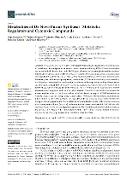Metabolites of De Novo Purine Synthesis: Metabolic Regulators and Cytotoxic Compounds

Author
Publication date
2022Published in
Metabolites [online]Volume / Issue
12 (12)ISBN / ISSN
ISSN: 2218-1989Metadata
Show full item recordCollections
This publication has a published version with DOI 10.3390/metabo12121210
Abstract
Cytotoxicity of de novo purine synthesis (DNPS) metabolites is critical to the pathogenesis of three known and one putative autosomal recessive disorder affecting DNPS. These rare disorders are caused by biallelic mutations in the DNPS genes phosphoribosylformylglycineamidine synthase (PFAS), phosphoribosylaminoimidazolecarboxylase/phosphoribosylaminoimidazolesuccinocarboxamide synthase (PAICS), adenylosuccinate lyase (ADSL), and aminoimidazole carboxamide ribonucleotide transformylase/inosine monophosphate cyclohydrolase (ATIC) and are clinically characterized by developmental abnormalities, psychomotor retardation, and nonspecific neurological impairment. At a biochemical level, loss of function of specific mutated enzymes results in elevated levels of DNPS ribosides in body fluids. The main pathogenic effect is attributed to the accumulation of DNPS ribosides, which are postulated to be toxic to the organism. Therefore, we decided to characterize the uptake and flux of several DNPS metabolites in HeLa cells and the impact of DNPS metabolites to viability of cancer cell lines and primary skin fibroblasts. We treated cells with DNPS metabolites and followed their flux in purine synthesis and degradation. In this study, we show for the first time the transport of formylglycinamide ribotide (FGAR), aminoimidazole ribotide (AIR), succinylaminoimidazolecarboxamide ribotide (SAICAR), and aminoimidazolecarboxamide ribotide (AICAR) into cells and their flux in DNPS and the degradation pathway. We found diminished cell viability mostly in the presence of FGAR and AIR. Our results suggest that direct cellular toxicity of DNPS metabolites may not be the primary pathogenetic mechanism in these disorders.
Keywords
purine synthesis, PFAS, PAICS, ADSL, ATIC, cytotoxicity, FGAR, AIR, SAICAR, AICAR,
Permanent link
https://hdl.handle.net/20.500.14178/1694License
Full text of this result is licensed under: Creative Commons Uveďte původ 4.0 International






